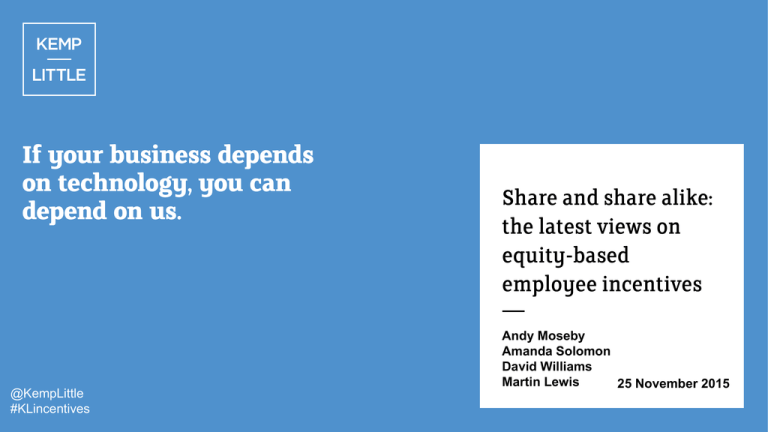Share and share alike
advertisement

Share and share alike: the latest views on equity-based employee incentives @KempLittle #KLincentives Andy Moseby Amanda Solomon David Williams Martin Lewis 25 November 2015 Agenda The importance of employee incentives Ways of giving value to your employees Share and option awards Valuation and example HR issues How tech companies get it wrong (and how you can put it right) Q&A @KempLittle #KLincentives _2 @KempLittle #KLincentives The importance of employee incentives The importance of employee incentives CIPD Report (Show me the money! The behavioural science of reward, 2015) – Individuals have a subjective view of their own worth which varies over time – Incentives need to be dynamic and flexible in line with employees’ expectations – Need for fairness (consistency) – Fail to value future reward so regular communication needed of value of deferred incentives (such as shares) – For executives, do bonuses promote short-termism? Consider both group and personal incentives Keep share incentives simple – not an incentive if participants don’t understand / appreciate value @KempLittle #KLincentives _4 Equity awards – initial issues to consider @KempLittle #KLincentives _5 Tax and Cash Management Employment Law Valuation and HMRC Commercial and Corporate Law @KempLittle #KLincentives Ways of giving value to your employees Ways of getting value to your employees Salary / remuneration Employer NIC 13.8% @KempLittle #KLincentives _7 Income tax and NIC 42% / 47% Shares Dividends Capital Income Tax: Tax free / 7.5% / 32.5% / 38.1% CGT 0% / 10% / 28% How to give an equity stake to your senior employees Equity Tax advantaged All Employee Plans SAYE Non-tax advantaged Discretionary Share Incentive Plans EMI / CSOP Options Discretionary ESS Shares Fully Paid Up @KempLittle #KLincentives _8 Unapproved Options Nil Paid HMRC statistics Companies operating Share Schemes 14,000 12,000 10,000 Any CSOP 8,000 6,000 4,000 2,000 0 @KempLittle #KLincentives _9 EMI SAYE SIP What’s new in the market place? EMI schemes remain popular Companies with higher market valuations ESS schemes for the following: Private Equity backed companies Management buy outs Start ups Companies with lower market valuations Growth share schemes / joint share ownership: Growth shares (growth from issue) Hurdle shares (growth above hurdle) Companies with higher market valuations @KempLittle #KLincentives _10 @KempLittle #KLincentives Share awards Types of shares awards @KempLittle #KLincentives _12 Simple Nil or partly paid Growth Gift Shares – pros and cons Pros Psychologically helpful because they are owners Cons Financial risk – initial cash outlay for shares May participate in dividends – nil paid Employees may want to see what other – partly paid shareholders see Simple concept May be interest relief on borrowings to acquire shares No EMI disqualifying events to worry about – gift (taxable) Valuation is complex – cannot agree value with HMRC before issue – post valuation check is possible but discretionary – valuation is complex Corporation tax deduction on issue of shares likely to be less valuable than on issue of shares on @KempLittle #KLincentives exercise of an option _13 Shares (including growth shares) – tax treatment Income Tax / NIC Employment related securities legislation – 2003 – very complex Income tax on acquisition of shares if pay less than UMV (can have nil paid or partly paid shares) Subsequent tax charges if UMV not paid and no election Can elect to be treated as paying UMV PAYE / NICs if readily convertible assets @KempLittle #KLincentives _14 Capital Gains Tax Disposal of ESS shares can be free of CGT Otherwise, gain on sale of shares is likely to be taxed at 28% Entrepreneurs’ relief available if, among other things, shareholder holds at least 5% of the ordinary share capital with at least 5% of the voting rights and remains employed @KempLittle #KLincentives Employee shareholder shares ESS taxation Income Tax First £2,000 of ESS shares is exempt from income tax and NICs (if no material interest) Shares worth >£2,000 are taxable on the excess Capital Gains Tax Disposal of ESS shares (valued at up to £50,000 on issue) is exempt from CGT No CGT relief if material interest (broadly more than 25%) NB: Valuation can be agreed with HMRC in advance of issue @KempLittle #KLincentives _16 No exemption for inter-spouse transfers of ESS shares ESS – key features Forego certain statutory employment rights Must have written statement of particulars Cannot have material interest (25%) ESS key features Issuing company does not need to be independent Independent advice must be given to employee Shares in employer or parent company @KempLittle #KLincentives _17 7 day cooling off period The ESS process Review reward strategy and consider alternatives Procedure ESS or share schemes? Advice from independent adviser May be relevant if EMI qualification not possible due to: – size – independence – working time @KempLittle #KLincentives _18 Written statement of particulars 7 day cooling off period Obtain HMRC to ESS valuation Strongly recommended Full disclosure required Helpful when exit Legal drafting Amend Articles of Association (if necessary) Statement of particulars Employee shareholder agreement Advice on becoming employee shareholder (by independent legal adviser) Reporting requirements to HMRC Immediate and ongoing compliance Sale of Company Extensive due diligence by buyer Tax risks if not properly implemented @KempLittle #KLincentives Share options Types of options @KempLittle #KLincentives _20 Unapproved EMI CSOP Combination Unapproved options – taxation Grant of option No income tax Exercise of option Income tax on difference between market value (MV) and exercise price Sale Entrepreneurs’ Relief Normally no CGT because Need 5% of exercised on exit CGT on difference PAYE and employee NIC between MV on exercise Employer NIC and sale proceeds voting power and share capital One year ownership requirement Rate normally 28% unless Must remain employed 10% ER applies @KempLittle #KLincentives _21 EMI / CSOP – taxation Grant of option No income tax Exercise of option No income tax Sale Capital gains tax Entrepreneurs’ Relief Do not need 5% of assuming no discount which is normally voting power or share at grant (EMI) taxed at 28% capital (EMI) No income tax if exercised Capital gains annual between three and 10 years after grant date (CSOP) exemption of £11,000 10% Entrepreneurs’ relief No one year ownership requirement (EMI) One year from date of grant to date of sale (EMI) Must remain employed @KempLittle #KLincentives _22 EMI – company qualifications Trading company £3 million unexercised options UK permanent establishment Property managing subsidiaries Company qualifications Qualifying subsidiaries Less than 250 employees Independence @KempLittle #KLincentives _23 Gross assets £30 million EMI – trading activities excluded Land dealing Legal and accountancy Selected Share dealers Excluded Trades Royalty / licence fee @KempLittle #KLincentives _24 Banking / insurance / financing EMI – employee requirements Employee of company or subsidiary Working time requirement 10 year exercise limit Employee requirements Unexercised options limited to £250,000 No material interest (30%) By reason of employment @KempLittle #KLincentives _25 The option process Review reward strategy and consider alternatives Agree performance criteria and other metrics Obtain HMRC as to company qualification Obtain HMRC to EMI / CSOP valuation Legal drafting Grant options Option agreement Timing of options Best practice ESS or share option Discussion with employee group Scheme rules Helpful on exit Strongly recommended Vesting dates Good / bad leaver @KempLittle #KLincentives _26 Full disclosure required Helpful on exit Articles Reporting requirements to HMRC Exercise Immediate and ongoing compliance Complex issues • May be part of sale Sale of Company Extensive due diligence by buyer Tax risks if not properly implemented @KempLittle #KLincentives Synthetic share awards Synthetic share awards – taxation Cash awards the value of which is linked to the value of the company's shares Often used by to grant awards to employees that mirror share options, in circumstances where actual share options are not appropriate or possible Generally discretionary Grant of award Cash payment under award No liability to income tax Income tax payable on cash amount Employee is awarded cash rather paid out under award Income tax payable through PAYE NICs also payable @KempLittle #KLincentives _28 Sale than shares or other securities, so tax on disposal is irrelevant @KempLittle #KLincentives Valuation and example Valuation – the key driver Drives decision-making process • What is feasible? Lower valuation • ESS • Shares Higher valuation • Options (EMI/CSOP/Unapproved) • Nil/partly paid shares • Growth shares @KempLittle #KLincentives _30 Valuation process Calculate maintainable earnings Identify appropriate multiple Other market transactions Discount factors EBITDA Directors transactions Risk Net assets Losses @KempLittle #KLincentives _31 EIS / SEIS Investor documents Minority HMRC correspondence Example valuation [1] @KempLittle #KLincentives £150,000 £900,000 £180,000 £36,000 Maintainable earnings Valuation using a multiple of 6 Pro rata value of 20% Valuation after taking minority discount of 80% _32 Example valuation [2] As above but: – Company is new and currently loss-making with net assets of £100,000 @KempLittle #KLincentives £0 £100,000 £20,000 £4,000 Maintainable earnings Valuation using Net Asset Value Pro rata value of 20% Valuation after taking minority discount of 80% _33 @KempLittle #KLincentives HR issues What happens on termination of employment? Typical consequences: – Unvested options lapse – Vested options: – Good leaver: can be exercised early/retained until they are exercised – Bad leaver: lapse Note potential timing considerations - Geys v Société Générale, London Branch [2012] _35 Approach to good leaver/bad leaver provisions Good leaver: Injury/ill health/disability, death, [retirement], redundancy, transfer of business/group company defining terms - eg redundancy potential for discrimination – age and disability TUPE – right to benefit from profit share or option scheme – MITIE Managed Services Ltd v French 2002 A bad leaver is everything else _36 Protecting the company from liability on termination Micklefield clause: "If any option holder ceases to be an executive for any reason he shall not be entitled, and by applying for an option an executive shall be deemed irrevocably to have waived any entitlement, by way of compensation for loss of office or otherwise howsoever to any sum or other benefit to compensate him for the loss of any rights under the scheme." Effective against wrongful dismissal but not: unfair dismissal claims - although compensation will be capped claims regarding discretion to permit the exercise of an option – Mallone v BPB Industries plc [2002] discrimination and whistleblowing claims _37 Penalty clauses Cavendish Square Holding BV v EL Makdessi and ParkingEye Ltd v Beavis [2015] • Is the provision a secondary obligation which imposes a detriment on a contract-breaker out of all proportion to any legitimate interest of the innocent party? • Is the provision penal? • Are the means by which the contracting party’s conduct is to be influenced (that is by a potential penal provision) “unconscionable or “extravagant” by reference to the norm? _38 Employee shareholder status Employees give up certain statutory rights including: – right to request flexible working – right to a statutory redundancy payment – right to claim unfair dismissal (subject to certain exceptions), but not protection from discrimination and in relation to whistleblowing Some statutory rights are different such as they must give 16 weeks' notice (rather than eight weeks) to the employer of their intention to return to return to work during the maternity/paternity leave period Any shareholder status agreement will have no effect unless: – the individual has been given written particulars and receives independent advice on terms and effect of the agreement – 7 days have passed since the date that he receives that advice Employees who refuse to accept employee shareholder status have enhanced protection from dismissal _39 @KempLittle #KLincentives How tech companies get it wrong (and how you can put it right) How tech companies get it wrong (and how you can put it right) Was exercise price less than market value? Issue EMI options once HMRC confirms the valuation (12 months rule) Issue EMI options prior to receiving an offer (otherwise valuation pegged to offer value) Provide for options exercising prior to a sale Consider an option audit well in advance of a sale Synthetic shares awards (financial promotion / financial assistance) Get it right, as rectification after the fact is difficult: – Prowting 1968 Trustee One Limited and others v Barry Amos-Yeo and Kevin Amos-Yeo [2015] EWHC 2480 (Ch) @KempLittle #KLincentives _41 @KempLittle #KLincentives Q&A Contact us Andy Moseby Corporate Partner +44(0) 20 7710 1650 andy.moseby@kemplittle.com Amanda Solomon KEMP LITTLE Cheapside House 138 Cheapside London EC2V 6BJ Head of Tax TEL FAX +44 (0) 20 7600 8080 +44 (0) 20 7600 7878 — kemplittle.com +44(0) 20 7600 8080 amanda.solomon@kemplittle.com Martin Lewis Tax Consultant +44(0) 20 7600 8080 martin.lewis@kemplittle.com David Williams Head of Employment @KempLittle #KLincentives Kemp Little LLP is a limited liability partnership registered in England and Wales (registered number: OC300242) and is authorised and regulated by the Solicitors Regulation Authority. Its registered office is Cheapside House, 138 Cheapside, London EC2V 6BJ. A list of members is open to inspection at the registered office. _43 +44(0) 20 7710 1641 david.williams@kemplittle.com


